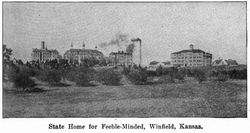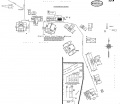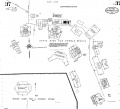Difference between revisions of "Winfield State Hospital"
Bill Sowers (talk | contribs) m (→Links) |
|||
| (2 intermediate revisions by 2 users not shown) | |||
| Line 45: | Line 45: | ||
<gallery> | <gallery> | ||
File:Winfield.jpg | File:Winfield.jpg | ||
| + | File:KSwinfield1905.jpg| ''1905'' | ||
| + | File:KSwinfield1912.jpg| ''1912'' | ||
| + | File:KSwinfield1918.jpg| ''1918'' | ||
| + | File:KSwinfield1947.jpg| ''1947'' | ||
</gallery> | </gallery> | ||
| Line 52: | Line 56: | ||
== Links == | == Links == | ||
| + | *[http://cdm16884.contentdm.oclc.org/cdm/singleitem/collection/p16884coll111/id/3/rec/4 Biennial Reports of the State Hospital at Winfield, 1881-1958] | ||
*[http://www.srskansas.org/SRSPress/1998/12898.html An article on the closure of the hospital] | *[http://www.srskansas.org/SRSPress/1998/12898.html An article on the closure of the hospital] | ||
*[http://www.ausbcomp.com/~bbott/cchm/9a/ndex.html Some photos] | *[http://www.ausbcomp.com/~bbott/cchm/9a/ndex.html Some photos] | ||
*[http://www.ausbcomp.com/~bbott/cchm/9c/ndex.html http://www.ausbcomp.com/~bbott/cchm/9c/ndex.html] | *[http://www.ausbcomp.com/~bbott/cchm/9c/ndex.html http://www.ausbcomp.com/~bbott/cchm/9c/ndex.html] | ||
| + | [[Category:Kansas]] | ||
[[Category:Closed Institution]] | [[Category:Closed Institution]] | ||
[[Category:Cottage Plan]] | [[Category:Cottage Plan]] | ||
| − | |||
[[Category:Institution With A Cemetery]] | [[Category:Institution With A Cemetery]] | ||
Latest revision as of 13:51, 9 September 2015
| Winfield State Hospital | |
|---|---|
 | |
| Construction Began | 1888 |
| Closed | 1998 |
| Current Status | Closed |
| Building Style | Cottage Plan |
| Location | Winfield, KS |
| Peak Patient Population | 1,494 in 1952 |
| Alternate Names |
|
Contents
[hide]History[edit]
The Winfield State Hospital opened initially in 1881 on the University of Kansas campus but soon relocated to the town of Winfield in 1887, receiving the name change "The Kansas State Asylum for Idiotic and Imbecile Youth" and had thirty-one students (Seaton, p. 252). The new location, further away from the more public University of Kansas central campus, allowed for the Asylum to become more self sufficient, using the young students as an indentured work force, raising vegetables, meat, grain, having its own water, and even putting out its own fires instead of relying on the public fire departments (Seaton, p. 252).
On July 1, 1893, Dr. F. Hoyt Pilcher was named the superintedent of the Asylum, after an increase in the number of students. This is the point at which the eugenics movement began to have a greater influence on the Winfield Institute with the Progressive movement. In this state home Pilcher “de-sexed” his patients (Paul, p. 617), no longer focusing on simply keeping the "feeble-minded" in the institution, but sterilizing them so that, in the event that they left the institution, they would not enter society sexually. The number of students at the Institute began to grow at an exponential rate. "In 1900 it was 173, and in 1910 it was 419. By 1916 it was 589" (Seaton, p. 253).
In 1909 the name changed to the State Home for the Feeble-Minded, after many of the epileptics in the institution had been sent to the newly founded Parsons Institute which attempted to use newly discovered medical treatments for epilepsy.
It is important to note that the original emphasis of the Winfield Institute was education, training those at the Institute to live in society. By the 1920s, however, the emphasis was placed on agricultural productivity as both the male and female clients were put to work throughout the institution, so that it could become its own system. no longer training the students to live in society, but training them to live in their own self-created world. By 1933 it was called a “custodial institution for the helpless” and the emphasis was on discipline, cost-cutting, and farm productivity, which included a name change again in 1930 to the State Training School. . At this time, further sterilizations occurred (Seaton, p. 254). The population at Winfield peaked during WWII when it reached 1,245 clients in 1942 (Seaton, p. 254).
After WWII, Kansas hospitals for the disabled were assessed and several problems were found at Winfield. Although there were not recorded accounts of physical abuse, handcuffs, leg irons, and whips were found in the hospital and in February 1987, 14 employees were fired and 13 were suspended after claims of client abuse in the men’s wards (Seaton, p. 257). In 1991, after a long history of turmoil at Winfield, the governmental process of closing the hospital’s doors began. It was part of a movement fostered by the idea that the developmentally disabled had civil rights that should be protected. Finally, in March 1998, after much debate, Winfield closed its doors, and it is now a correctional facility (Seaton, p. 261; Kansas Department of Corrections). The hospital’s closing seems long coming, as throughout Winfield’s 116-year existence, it continuously suffered from “an uncertain mission, a troubled relationship with the state and the community, and overcrowding due to almost nonexistent admission policies” (Seaton, p. 263). Today, three community-based programs serve more than 250 clients in Cowley County, and more than 100 of them came from Winfield.
- 1984-Winfield Pre-Release Center opened on the grounds of the Winfield State Hospital, providing primarily pre-release programming services. The population capacity was 141 inmates.
- 1989-Having expanded both in terms of size and facility mission, the name of the facility was changed to Winfield Correctional Facility. The population capacity was 290 inmates.
- 1996-Winfield State Hospital closed. As a result, Winfield Correctional Facility absorbed many buildings and the infrastructure and support units from the hospital. During the transition, an additional dorm was added, increasing the capacity to 522 inmates. In September, the administrations of Winfield Correctional Facility and Wichita Work Release Facility were combined.
- This institution was turned into a prison.
Images[edit]
Cemetery[edit]
Approximately 850 patients are buried in a cemetery on the property



